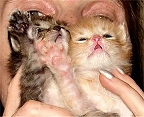| Cats use their tails to communicate their emotions, both to other cats and to humans. Below are some typical "tail postures" you will see, and what they mean. |  |
 |
If the tail is curved gently downward, then curved up again at the tip: The cat is relaxed and comfortable. |
 |
If the the tail is slightly raised and softly curved:; The cat is beginning to get interested in something. |
 |
If the tail is erect, but tip is tilted over, either forward or back: The cat is very interested and feeling friendly. |
 |
If the tail is fully erect and tip is vertical: The cat is offering a friendly, cheerful greeting. |
 |
If the tail is erect with whole length or tip quivering gently: The cat is showing affection. |
 |
If the tail is still, but the tip is twitching occasionally: The cat is slightly irritated or pensive. |
 |
If the tail is still, but tip is twitching intensely: The cat is very annoyed. |
 |
If the tail is swishing vigorously from side to side: The cat is angry.* |
 |
If the tail is straight up and fully bristled: The cat is showing aggression. |
 |
If the tail is arched and bristled: The cat may attack if further provoked. |
 |
If the tail is lowered and fluffed out: The cat is afraid. |
 |
If the tail is raised and fluffed out (the "Big Tail"): The cat is probably happily chasing around. |
 |
If the tail is fully lowered, perhaps tucked between hind legs: The cat is showing defeat or submissiveness (toward another cat). |
| If the tail is held to one side, and the cat is crouched or with rump in air: This female cat is ready to mate. |
Reference: http://www.xmission.com/~emailbox/tailtalk.htm

